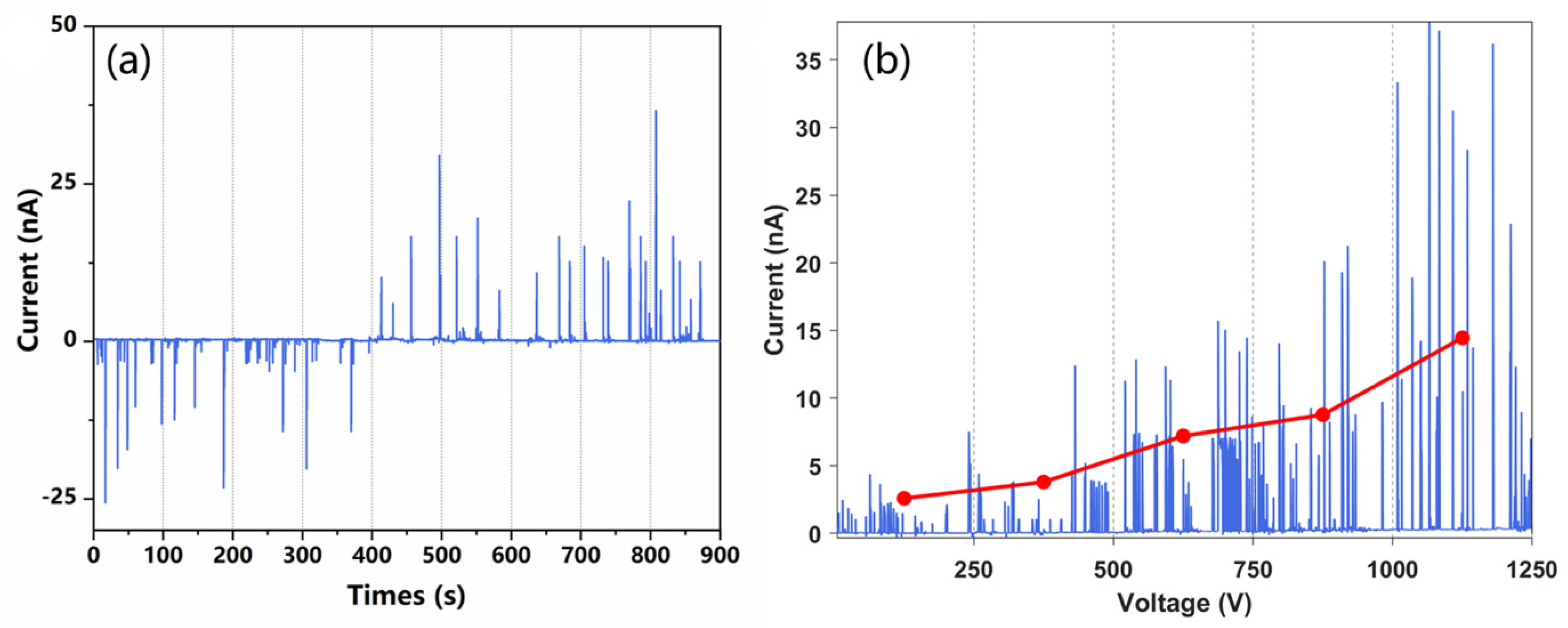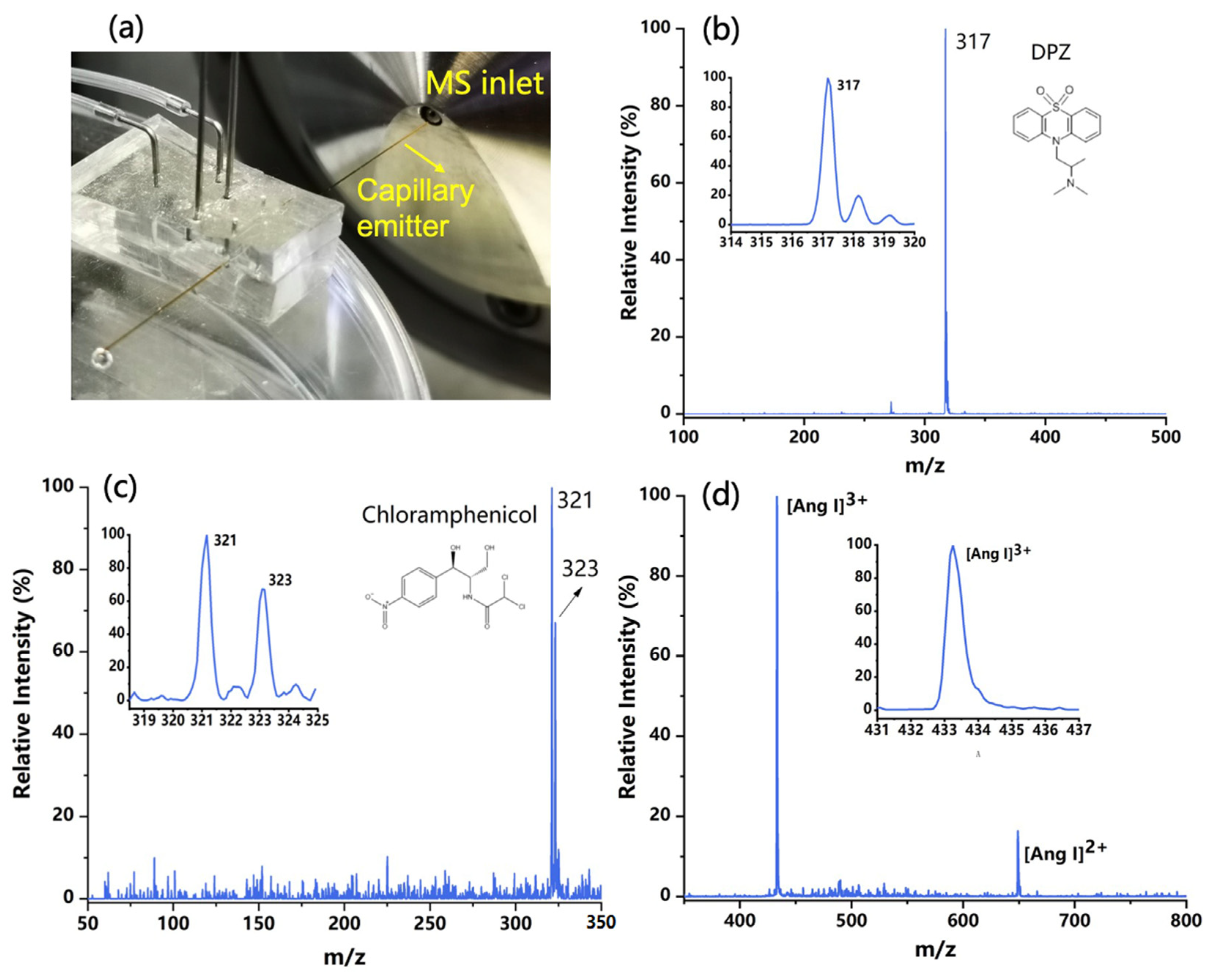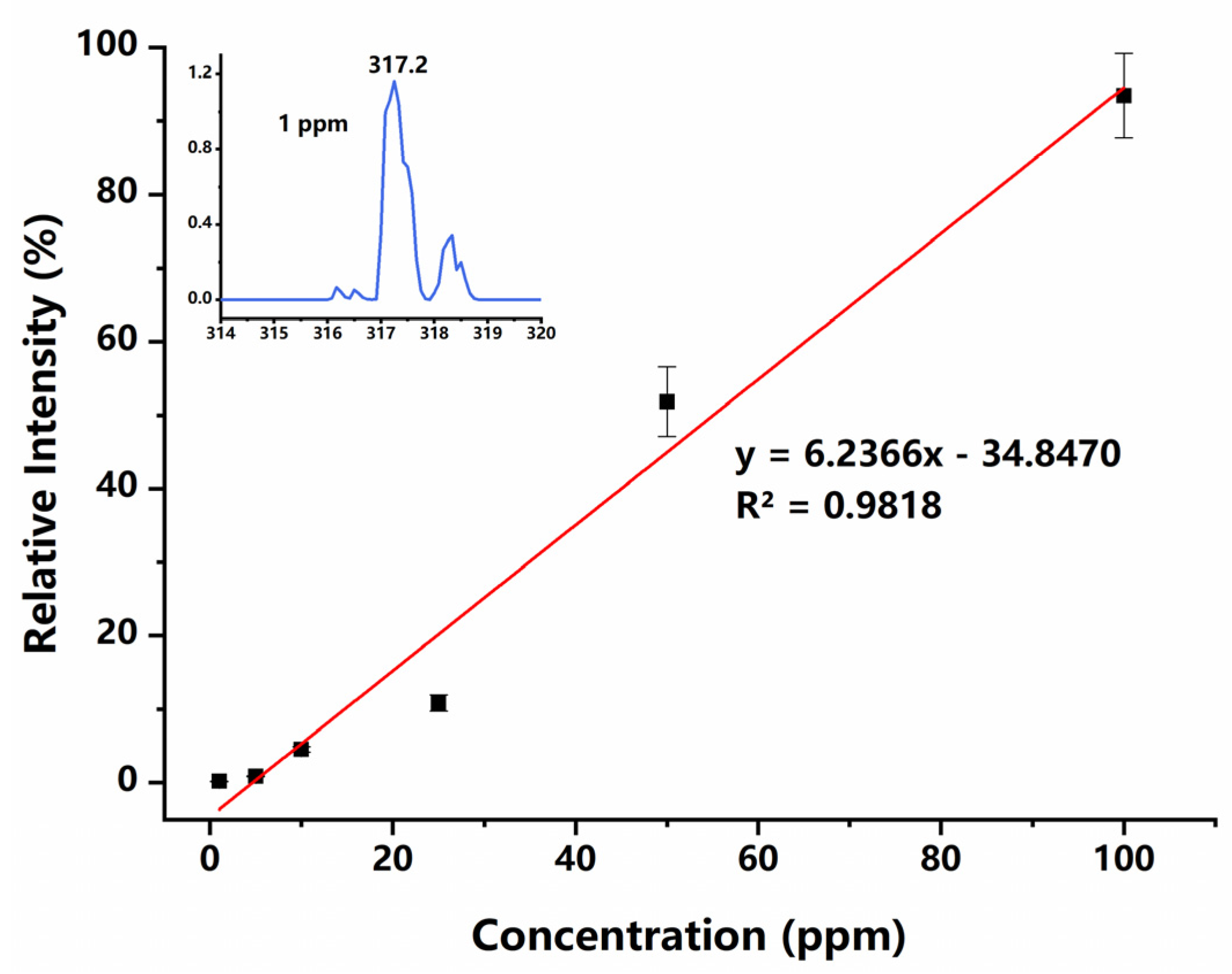Fabricating an Electrospray Ionization Chip Based on Induced Polarization and Liquid Splitting
Abstract
:1. Introduction
2. Materials and Methods
2.1. Materials and Instruments
2.2. Device Structure and Fabrication
3. Results and Discussion
4. Conclusions
Author Contributions
Funding
Conflicts of Interest
References
- Song, H.; Chen, D.L.; Ismagilov, R.F. Reactions in droplets in microflulidic channels. Angew. Chem.-Int. Ed. 2006, 45, 7336–7356. [Google Scholar] [CrossRef] [PubMed] [Green Version]
- Song, H.; Tice, J.D.; Ismagilov, R.F. A microfluidic system for controlling reaction networks in time. Angew. Chem.-Int. Ed. 2003, 42, 768–772. [Google Scholar] [CrossRef] [PubMed]
- Whitesides, G.M. The origins and the future of microfluidics. Nature 2006, 442, 368–373. [Google Scholar] [CrossRef] [PubMed]
- Liu, Y.; Jiang, X.Y. Why microfluidics? Merits and trends in chemical synthesis. Lab Chip 2017, 17, 3960–3978. [Google Scholar] [CrossRef] [PubMed]
- Snyder, D.T.; Pulliam, C.J.; Ouyang, Z.; Cooks, R.G. Miniature and Fieldable Mass Spectrometers: Recent Advances. Anal. Chem. 2016, 88, 2–29. [Google Scholar] [CrossRef] [PubMed] [Green Version]
- Shi, W.; Huo, X.; Tian, Y.; Lu, X.; Yang, L.; Yu, Q.; Wang, X. Development of membrane inlet photoionization ion trap mass spectrometer for trace VOCs analysis. Talanta 2021, 230, 122352. [Google Scholar] [CrossRef]
- Zhang, Q.; Tian, Y.; Aliang, M.; Yu, Q.; Wang, X. Implementation and study of dopant-assisted photoionization with a miniature capillary inlet ion trap mass spectrometer. Rapid Commun. Mass Spectrom. 2020, 34, e8621. [Google Scholar] [CrossRef]
- Huo, X.; Chen, D.; Tian, Y.; Li, M.; Yu, Q.; Guo, C.; Wang, X. Asymmetric rectilinear ion trap with unidirectional ion ejection capability. J. Mass Spectrom. 2020, 55, e4606. [Google Scholar] [CrossRef]
- Yu, Q.; Li, M.; Lu, X.; Wang, X. Geometric optimization of toroidal ion trap based on electric field analysis and SIMION simulation. Int. J. Mass Spectrom. 2018, 434, 60–64. [Google Scholar] [CrossRef]
- Meng, X.; Tang, C.; Zhang, C.; Li, D.; Xu, W.; Zhai, Y. A “Brick” Mass Spectrometer with Photoionization for Direct Analysis of Trace Volatile Compounds. J. Am. Soc. Mass Spectrom. 2020, 31, 961–968. [Google Scholar] [CrossRef]
- Oleschuk, R.D.; Harrison, D.J. Analytical microdevices for mass spectrometry. Trends Anal. Chem. 2000, 19, 379–388. [Google Scholar] [CrossRef]
- He, X.; Chen, Q.; Zhang, Y.; Lin, J.-M. Recent advances in microchip-mass spectrometry for biological analysis. Trends Anal. Chem. 2014, 53, 84–97. [Google Scholar] [CrossRef]
- Gasilova, N.; Yu, Q.; Qiao, L.; Girault, H.H. On-Chip Spyhole Mass Spectrometry for Droplet-Based Microfluidics. Angew. Chem. Int. Ed. 2014, 53, 4408–4412. [Google Scholar] [CrossRef] [PubMed] [Green Version]
- Kempa, E.E.; Smith, C.A.; Li, X.; Bellina, B.; Richardson, K.; Pringle, S.; Galman, J.L.; Turner, N.J.; Barran, P.E. Coupling Droplet Microfluidics with Mass Spectrometry for Ultrahigh-Throughput Analysis of Complex Mixtures up to and above 30 Hz. Anal. Chem. 2020, 92, 12605–12612. [Google Scholar] [CrossRef]
- Sung, W.-C.; Makamba, H.; Chen, S.-H. Chip-based microfluidic devices coupled with electrospray ionization-mass spectrometry. Electrophoresis 2005, 26, 1783–1791. [Google Scholar] [CrossRef]
- Heiland, J.J.; Warias, R.; Lotter, C.; Mauritz, L.; Fuchs, P.J.W.; Ohla, S.; Zeitler, K.; Belder, D. On-chip integration of organic synthesis and HPLC/MS analysis for monitoring stereoselective transformations at the micro-scale. Lab Chip 2017, 17, 76–81. [Google Scholar] [CrossRef] [Green Version]
- Beulig, R.J.; Warias, R.; Heiland, J.J.; Ohla, S.; Zeitler, K.; Belder, D. A droplet-chip/mass spectrometry approach to study organic synthesis at nanoliter scale. Lab Chip 2017, 17, 1996–2002. [Google Scholar] [CrossRef]
- Li, X.; Xu, R.; Wei, X.; Hu, H.; Zhao, S.; Liu, Y.-M. Direct Analysis of Biofluids by Mass Spectrometry with Microfluidic Voltage-Assisted Liquid Desorption Electrospray Ionization. Anal. Chem. 2017, 89, 12014–12022. [Google Scholar] [CrossRef]
- Koster, S.; Verpoorte, E. A decade of microfluidic analysis coupled with electrospray mass spectrometry: An overview. Lab Chip 2007, 7, 1394–1412. [Google Scholar] [CrossRef] [PubMed]
- Qiao, L.; Sartor, R.; Gasilova, N.; Lu, Y.; Tobolkina, E.; Liu, B.; Girault, H.H. Electrostatic-Spray Ionization Mass Spectrometry. Anal. Chem. 2012, 84, 7422–7430. [Google Scholar] [CrossRef] [PubMed] [Green Version]
- Brivio, M.; Fokkens, R.H.; Verboom, W.; Reinhoudt, D.N.; Tas, N.R.; Goedbloed, M.; van den Berg, A. Integrated microfluidic system enabling (bio)chemical reactions with on-line MALDI-TOF mass spectrometry. Anal. Chem. 2002, 74, 3972–3976. [Google Scholar] [CrossRef]
- Fenn, J.B.; Mann, M.; Meng, C.K.; Wong, S.F.; Whitehouse, C.M. Electrospray ionization–principles and practice. Mass Spectrom. Rev. 1990, 9, 37–70. [Google Scholar] [CrossRef]
- Cech, N.B.; Enke, C.G. Practical implications of some recent studies in electrospray ionization fundamentals. Mass Spectrom. Rev. 2001, 20, 362–387. [Google Scholar] [CrossRef]
- Yu, Q.; Zhang, Q.; Lu, X.; Qian, X.; Ni, K.; Wang, X. Developing a Vacuum Electrospray Source To Implement Efficient Atmospheric Sampling for Miniature Ion Trap Mass Spectrometer. Anal. Chem. 2017, 89, 12938–12944. [Google Scholar] [CrossRef] [PubMed]
- Yu, Q.; Zhang, J.; Ni, K.; Qian, X.; Wang, X. Characterization and application of a self-aspirating electrospray source with pneumatic-assisted ionization. J. Mass Spectrom. 2017, 52, 109–115. [Google Scholar] [CrossRef] [PubMed]
- Tang, H.; Yu, Q.; Qian, X.; Ni, K.; Wang, X. Fabricating and Characterizing the Microfluidic Solid Phase Extraction Module Coupling with Integrated ESI Emitters. Micromachines 2018, 9, 212. [Google Scholar] [CrossRef] [PubMed] [Green Version]
- Xiang, Q.; Jie, X.; Cilong, Y.; Yan, C.; Quan, Y.; Kai, N.; Xiaohao, W. A Reliable and Simple Method for Fabricating a Poly(Dimethylsiloxane) Electrospray Ionization Chip with a Corner-Integrated Emitter. Sensors 2015, 15, 8931–8944. [Google Scholar] [CrossRef] [Green Version]
- Yu, C.; Tang, F.; Qian, X.; Chen, Y.; Yu, Q.; Ni, K.; Wang, X. Multi-channel microfluidic chip coupling with mass spectrometry for simultaneous electro-sprays and extraction. Sci. Rep. 2017, 7, 17389. [Google Scholar] [CrossRef] [Green Version]
- Li, G.; Huang, G. Alleviation of ion suppression effect in sonic spray ionization with induced alternating current voltage. J. Mass Spectrom. 2014, 49, 639–645. [Google Scholar] [CrossRef]
- Manisali, I.; Chen, D.D.Y.; Schneider, B.B. Electrospray ionization source geometry for mass spectrometry: Past, present, and future. Trends Anal. Chem. 2006, 25, 243–256. [Google Scholar] [CrossRef]
- Huang, G.; Li, G.; Cooks, R.G. Induced Nanoelectrospray Ionization for Matrix-Tolerant and High-Throughput Mass Spectrometry. Angew. Chem. Int. Ed. 2011, 50, 9907–9910. [Google Scholar] [CrossRef]
- Wei, Z.; Xiong, X.; Guo, C.; Si, X.; Zhao, Y.; He, M.; Yang, C.; Xu, W.; Tang, F.; Fang, X.; et al. Pulsed Direct Current Electrospray: Enabling Systematic Analysis of Small Volume Sample by Boosting Sample Economy. Anal. Chem. 2015, 87, 11242–11248. [Google Scholar] [CrossRef] [PubMed]
- Zhang, Q.; Zhu, Y.; Tian, Y.; Yu, Q.; Wang, X. Induced Self-aspiration Electrospray Ionization Mass Spectrometry for Flexible Sampling and Analysis. Anal. Chem. 2020, 92, 4600–4606. [Google Scholar] [CrossRef]
- Lu, X.; Chen, H.; Li, X.; Chen, J.; Yang, X. A simplified electrospray ionization source based on electrostatic field induction for mass spectrometric analysis of droplet samples. Analyst 2012, 137, 5743–5748. [Google Scholar] [CrossRef] [PubMed]
- Ikonomou, M.G.; Blades, A.T.; Kebarle, P. Electrospray-ion spray: A comparison of mechanisms and performance. Anal. Chem. 1991, 63, 1989–1998. [Google Scholar] [CrossRef]
- Link, D.R.; Grasland-Mongrain, E.; Duri, A.; Sarrazin, F.; Cheng, Z.D.; Cristobal, G.; Marquez, M.; Weitz, D.A. Electric control of droplets in microfluidic devices. Angew. Chem.-Int. Ed. 2006, 45, 2556–2560. [Google Scholar] [CrossRef] [PubMed]
- Timung, S.; Chaudhuri, J.; Borthakur, M.P.; Mandal, T.K.; Biswas, G.; Bandyopadhyay, D. Electric field mediated spraying of miniaturized droplets inside microchannel. Electrophoresis 2017, 38, 1450–1457. [Google Scholar] [CrossRef] [PubMed]
- Rao, L.; Cai, B.; Wang, J.; Meng, Q.; Ma, C.; He, Z.; Xu, J.; Huang, Q.; Li, S.; Cen, Y.; et al. A microfluidic electrostatic separator based on pre-charged droplets. Sens. Actuators B Chem. 2015, 210, 328–335. [Google Scholar] [CrossRef]






Publisher’s Note: MDPI stays neutral with regard to jurisdictional claims in published maps and institutional affiliations. |
© 2021 by the authors. Licensee MDPI, Basel, Switzerland. This article is an open access article distributed under the terms and conditions of the Creative Commons Attribution (CC BY) license (https://creativecommons.org/licenses/by/4.0/).
Share and Cite
Zhou, L.; Zhang, Q.; Xu, X.; Huo, X.; Zhou, Q.; Wang, X.; Yu, Q. Fabricating an Electrospray Ionization Chip Based on Induced Polarization and Liquid Splitting. Micromachines 2021, 12, 1034. https://doi.org/10.3390/mi12091034
Zhou L, Zhang Q, Xu X, Huo X, Zhou Q, Wang X, Yu Q. Fabricating an Electrospray Ionization Chip Based on Induced Polarization and Liquid Splitting. Micromachines. 2021; 12(9):1034. https://doi.org/10.3390/mi12091034
Chicago/Turabian StyleZhou, Lvhan, Qian Zhang, Xiangchun Xu, Xinming Huo, Qian Zhou, Xiaohao Wang, and Quan Yu. 2021. "Fabricating an Electrospray Ionization Chip Based on Induced Polarization and Liquid Splitting" Micromachines 12, no. 9: 1034. https://doi.org/10.3390/mi12091034





